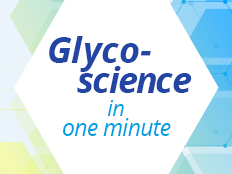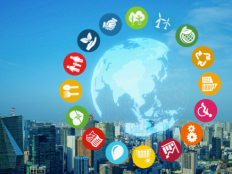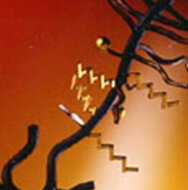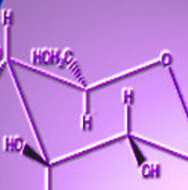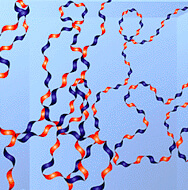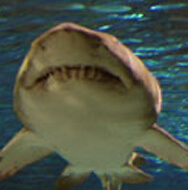It is said that the number of cells that constitutes the human body is approximately 60 trillion. When this many cells repeat metabolism with old cells replacing new cells to maintain the "small universe" that is the human body, what kind of mechanism is used to adjust cell proliferation?
The control mechanism of cell proliferation varies depending on the tissue, cell type, etc. It is generally believed that a substance called growth factor is involved.
Growth factor is a polypeptide hormone that regulates cell division, and up until now various factors such as fibroblast growth factor (FGF), platelet-derived growth factor (PDGF), and nerve growth factor (NGF) have been discovered. For example, insulin which was introduced in Part 3: "The most accessible source of energy", actually functions as a growth factor as well as adjusting glucose metabolism. An insulin-like growth factor having a structure similar to that of insulin precursor and having potent cell proliferative activity has also been discovered.
As noted above, growth factors, involve various substances with varying functions, and including some whose activities are adjusted by sugar chains. These are a group of substances collectively referred to as heparin binding growth factor.
Heparin binding growth factor was so named because it has the characteristic of specifically binding to heparan sulfate, which widely exists on the cell surface of mammals, and its companion heparin. Among the growth factors noted above ,fibroblast growth factor, hepatic cell growth factor, and platelet-derived growth factor are classified as heparin binding growth factors. In heparan sulfate, different from chondroitin sulfate, it is known that sulfate radicals are unevenly distributed over the entire sugar chain. Portions with locally dense sulfate radicals will have a strongly negative charge, thus forming a unique structure, and this portion interacts with heparin binding growth factor to affect the activity of the growth factor.
Specifically speaking, how does heparan sulfate adjust the activity of heparin binding growth factor?
This will be explained using one of the more understood examples, FGF-2 (fibroblast growth factor).
In the process of FGF-2 action, it must first bind to an FGF receptor on the cell surface. Referring to FGF-2 as a "signal", FGF receptor can be taken as a kind of "antenna" to transmit its signal to the inside of the cell (like the "key and keyhole" described in Part 2 , the shapes of the binding sites are important for the two to bind.) In reality however, when FGF-2 exists alone, its "signal" cannot be caught with good sensitivity by the "antenna", and it is easily degraded by proteolytic enzymes. Heparan sulfate on the cell surface has an important role here. When FGF-2 binds with heparan sulfate, its structure changes to facilitate binding with FGF receptor. It will also be protected from proteolytic enzyme attacks, and thus accumulate within the extracellular matrix without diffusing more than necessary within the tissue. In other words, heparan sulfate acts as a "protector" of FGF-2.
In addition, heparan sulfate is believed to interact with FGF receptor as well. FGF receptor also cannot transmit its signal to the inside of the cell just by binding with FGF-2. It is known that only after the two FGF receptors are united can they function effectively, and heparan sulfate is speculated to facilitate this. A definitive conclusion as to how heparan sulfate and FGF receptor interact has not yet been reached. There is however, no doubt that heparan sulfate plays an important role in the binding of FGF-2 to FGF receptor and subsequent transmission of its signal to the inside of the cell.
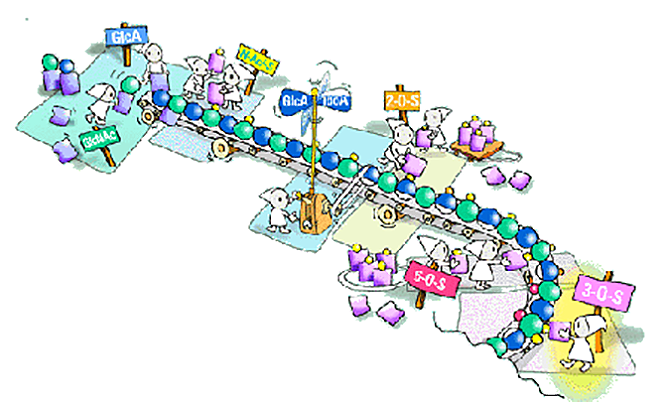
▲ Biosynthesis of Heparin/Heparan Sulfate
Control of cell proliferation is one of the phenomena associated with the foundations of life. It is an extremely complex process, and there are still many parts of it that are unknown. Its grand design may be clarified in the future as elucidations of sugar chain functions proceed.
♦Glycoforum
In "Glycoscience NOW" which is a subject under"Glycoforum", the cutting edge of glycoscience as well as new developments and research results on hyaluronic acid are introduced, especially for those interested in glycoscience and may be studying glycoscience in the future.
Commentary on message of heparin/heparan sulfate sugar chain
In "GlycoWord", a subcategory of "Glycoforum", key words of research in glycoscience are classified into genres, and a specialized researcher in that field has written a commentary.
About Proteoglycan
Growth Factor and Heparan Sulfate

